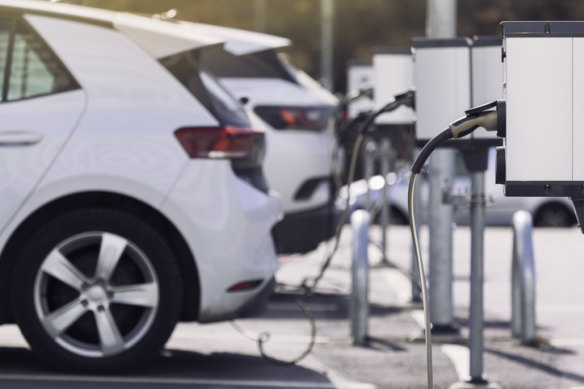- Sponsored
- Technology
- BHP
Rise of the e-machines
Sponsored by BHP
The electrification of transport is one of the world’s megatrends - and it’s beginning right now. According to US energy transition think tank Rocky Mountain Institute (RMI), “there is a clear exponential growth pattern for electric vehicle (EV) sales.”
“If EV sales continue to accelerate — and tricky problems such as charging stations are addressed — then EV sales could comprise 62 to 86 per cent of auto sales globally by 2030,” RMI says.

EVs could comprise 62 to 86 per cent of auto sales globally by 2030.Credit: iStock
These numbers are supported by the International Energy Agency’s (IEA) Global EV Outlook for 2023, which found sales exceeded 10 million in 2022, representing 14 per cent of the year’s car sales globally.
The IEA’s outlook estimates almost one in five cars sold worldwide this year will be an electric vehicle, compared with just 4 per cent of global car sales in 2020.
Over 2.3 million electric cars were sold in the first quarter of this year according to the IEA, about 25 per cent more than in the same period last year and they predict an annual 35 per cent increase year-on-year.
Bearing all this in mind, the RMI believes sales of internal combustion engine (ICE) vehicles peaked in 2017, petrol demand peaked in 2019, and the ICE fleet will peak in the middle of the decade.
“Oil demand for cars will then be squeezed between continued efficiency gains and the rise of EVs,” the RMI said in a recent research paper.
While timing for the ICE vehicle peak may vary across a range of projections, the ongoing growth in EV demand is seen as inevitable and, with the rise of EVs, the demand for vital minerals such as copper and nickel is expected to increase considerably so the world’s automotive companies can manufacture more cost-effective, efficient batteries that are powerful and can be driven long distances, and because an EV uses around three to four times more copper than a comparable ICE vehicle.
During an earnings call back in 2020, Tesla’s Elon Musk pleaded for mining companies to mine more nickel. On the call, Musk asked miners to “go for efficiency, obviously environmentally-friendly nickel mining at high volume”.
BHP has signed a nickel supply agreement with Tesla Inc. for nickel sourced from BHP’s Nickel West operations in Western Australia - which has one of the lowest carbon emission production intensities of benchmarked nickel mines and processing plants.

Vandita Pant, BHP chief commercial officer.
At the time of the deal in July 2021, BHP chief commercial officer, Vandita Pant, said: “Demand for nickel in batteries is estimated to grow by over 500 per cent over the next decade, in large part to support the world’s rising demand for electric vehicles.”
“We are delighted to sign this agreement with Tesla Inc., and to collaborate with them on ways to make the battery supply chain more sustainable through our shared focus on technology and innovation,” Pant said.
In addition to the supply agreement, BHP and Tesla are collaborating on ways to make the battery supply chain more sustainable, with a focus on end-to-end raw material traceability using blockchain; technical exchange for battery raw materials production; and promotion of the importance of sustainability in the resources sector.
BHP also undertook to collaborate with Tesla on energy storage solutions to identify opportunities to lower carbon emissions in their respective operations through increased use of renewable energy paired with battery storage.
Furthermore, BHP is also strongly focused on playing its role in tackling the climate challenge and believes mining companies should be industry leaders.
In 2021, it partnered with two peer resource companies, Rio Tinto and Vale, to launch the Charge On Innovation Challenge, a global competition for technology innovators to develop new concepts for large-scale haul truck electrification systems to help significantly cut emissions from surface mine operations and unlock safety, productivity, and operational improvements. The global challenge resulted in eight technology innovators being selected last year from a short-list of 21 companies to collaborate with industry to accelerate their novel electric truck charging solution concepts.
Looking at one of the critical minerals, BHP estimates under its 1.5 degree scenario that cumulative primary copper demand would double over the next 30 years compared to the demand of the previous 30, and they’re well placed to be a significant player in the world’s electrification revolution.
Looking beyond the critical minerals needed in actual car and battery manufacturing, there will also be a need for a vast rollout of electric vehicle charging infrastructure globally.
According to Bloomberg New Energy Finance, the cumulative investment in electric vehicles would need to reach $US91.5 trillion from 2022-50 in its Net Zero Scenario or roughly 100 per cent of world GDP in current US dollars.
It makes the global journey to a lower carbon-intensive energy future a huge challenge, but one BHP can play a vital role in.
To learn more, visit www.bhp.com.